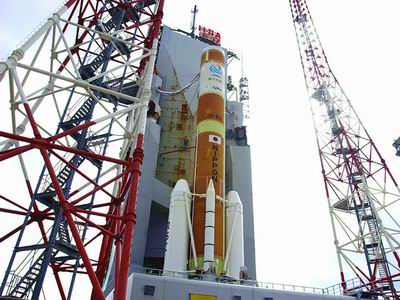| Space: Taiwan And Japan In The Same Orbit
空间:台湾地区和日本在同一轨道 Date:2016-08-01 Source:strategypage By:Globalmil Viewed: |

日本H-2A运载火箭
July 30, 2016:Taiwan and Japan are working out, as quietly as possible, a sharing arrangement so Taiwan can make use of Japanese spy satellites until Taiwan can launch its new Formosat 5. The Formosat 5 was supposed to go up in mid-2015 but the American launcher failed a test and had to reschedule. That launch will take place in late 2016 and Taiwan needs some help because the Taiwanese surveillance satellite it was relying on (Formosat 2) is old and showing signs of failing. Taiwan has worked closely with American satellite manufacturers to develop Taiwanese manufactured satellites. But American firms launch Taiwanese satellites.
2016年7月30日:台湾地区和日本正在安排,尽可能平静,共享约定,台湾地区可以利用日本的间谍卫星,直到台湾地区能推出新的福卫5卫星,福卫5卫星应该在2015年中期上天,但美国发射测试失败,不得不重新安排。这次发射将在2016年年底并且台湾地区需要一些帮助,因为台湾地区的监视卫星的依托(福卫2)是陈旧的,显示出失效的迹象。台湾地区与美国卫星制造商密切合作,开发台湾地区制造的卫星。但美国公司发射台湾地区的卫星。
Taiwan has been quietly building and launching its own space satellite since the late 1990s. To avoid a major Chinese effort to derail this program Taiwan made sure all its satellites had scientific purposes. But by 2004 Taiwan was putting up dual (scientific/military) purpose satellites like their photo and remote sensing satellites. Japan has one of the most advanced space programs in the region and because Taiwan and Japan both fear China, it made sense for Taiwan to quietly seek Japanese assistance.
台湾地区一直在悄悄地制造并自20世纪90年代末发射了自己的人造卫星。为了避免主要是中国大陆试图阻挠这个计划台湾地区安排确保所有的卫星有科研目。但到了2004年台湾地区搭建双(科学/军事)用途卫星像他们的照相和遥感卫星。日本在该地区是最先进的太空计划之一,因为台湾地区和日本担心中国大陆,台湾地区静静地寻求日本的援助是有道理的。
台湾地区一直在悄悄地制造并自20世纪90年代末发射了自己的人造卫星。为了避免主要是中国大陆试图阻挠这个计划台湾地区安排确保所有的卫星有科研目。但到了2004年台湾地区搭建双(科学/军事)用途卫星像他们的照相和遥感卫星。日本在该地区是最先进的太空计划之一,因为台湾地区和日本担心中国大陆,台湾地区静静地寻求日本的援助是有道理的。
Japan launched its first space satellite in 1970 and became the fourth nation (after Russia, America and France) to do so. For decades Japan mainly launched scientific satellites. In the late 1990s Japan, alarmed at the threat of attack by North Korea, began developing and launching military satellites. The first two were launched in 2003, the third in 2006 and the fourth in 2007. Japan continues to build and launch photo and radar satellites. While Japan buys some launcher and satellite tech from foreign nations (mainly the U.S.) Japan has become quite proficient in both areas.
日本于1970年发射其首个太空卫星,这样做并成为全球第四个国家(仅次于俄罗斯,美国和法国)。几十年来,日本主要发展科学卫星。在90年代末期日本对朝鲜攻击的威胁感到震惊,开始研制和发射军用卫星。前两颗分别在2003年发射,在2006年第三颗,2007年日本继续制造和发射第四颗照相和雷达卫星。而日本从外国购买一些运载火箭和卫星技术(主要是美国),日本在这两个方面已变得相当精通。
日本于1970年发射其首个太空卫星,这样做并成为全球第四个国家(仅次于俄罗斯,美国和法国)。几十年来,日本主要发展科学卫星。在90年代末期日本对朝鲜攻击的威胁感到震惊,开始研制和发射军用卫星。前两颗分别在2003年发射,在2006年第三颗,2007年日本继续制造和发射第四颗照相和雷达卫星。而日本从外国购买一些运载火箭和卫星技术(主要是美国),日本在这两个方面已变得相当精通。
By 201o the cameras on board Japanese photo satellites could make out objects as small as one meter (39 inches) in diameter. By 2013 a new Japanese photo satellite could detect objects .6 meters (two feet) in size. The best U.S. spy satellites can make out much smaller objects, but for Japan's needs .6-1 meters is adequate. The radar satellites provide all weather coverage.
在2010年日本在轨照相卫星的相机能辨认出小到直径一米(39英寸)的物体。到2013年,一颗新的日本照相卫星可以辨认出大小0.6米(二英尺)的物体。最好的美国间谍卫星可以辨认出更小的物体,但对日本的需求0.6-1米就足够了。雷达卫星提供全天候覆盖。
在2010年日本在轨照相卫星的相机能辨认出小到直径一米(39英寸)的物体。到2013年,一颗新的日本照相卫星可以辨认出大小0.6米(二英尺)的物体。最好的美国间谍卫星可以辨认出更小的物体,但对日本的需求0.6-1米就足够了。雷达卫星提供全天候覆盖。
Technically, the satellites are in violation of a 1969 Japanese law, which mandated Japan only use space for non-military purposes. To get around this these satellites are technically non-military and are not controlled by the military. Japan had long refrained from launching military satellites but this changed when North Korea fired a ballistic missile over Japan in 1998. Japan promptly set out to get eight surveillance satellites in orbit by 2006, in order to keep an eye on North Korean nuclear weapons and ballistic missile efforts. This proved impossible to do. While two Japanese satellites were launched in early 2003, another two were destroyed during late 2003, when the rocket malfunctioned.
技术上,日本的卫星违反了1969年日本宪法,规定日本仅能非军事用途使用空间。为了绕过这个问题,这些卫星在技术上非军事不被军方控制。日本已经很久没有发射军事卫星但这被改变,朝鲜在1998年发射一枚弹道导弹穿越日本,日本迅速着手在轨道上部署八颗监控卫星,保持对朝鲜核武器和弹道导弹监视的努力。事实证明,这是不可能的事情。虽然两颗日本卫星是在2003年年初发射,另外两颗2003年底被毁掉,当时火箭出现故障。
技术上,日本的卫星违反了1969年日本宪法,规定日本仅能非军事用途使用空间。为了绕过这个问题,这些卫星在技术上非军事不被军方控制。日本已经很久没有发射军事卫星但这被改变,朝鲜在1998年发射一枚弹道导弹穿越日本,日本迅速着手在轨道上部署八颗监控卫星,保持对朝鲜核武器和弹道导弹监视的努力。事实证明,这是不可能的事情。虽然两颗日本卫星是在2003年年初发射,另外两颗2003年底被毁掉,当时火箭出现故障。

日本2003年底发射间谍卫星因火箭故障自毁,日本宇宙開發事業團總裁謝罪
Japan has long relied on commercial photo satellites and whatever they could get from the Americans. But for high resolution shots, on demand, of North Korea, and electronic eavesdropping from space, they need their own spy satellites. It is believed that the Japanese spy satellites are also being used to watch military developments in China and Russia.
长期以来,日本一直依靠商业卫星照片和任何他们可以从美国人那得到的。但是对于高分辨率镜头,随需应变,对朝鲜和从空间电子窃听,他们需要自己的间谍卫星。据认为,日本的间谍卫星也被用于监视中国和俄罗斯的军事发展。
长期以来,日本一直依靠商业卫星照片和任何他们可以从美国人那得到的。但是对于高分辨率镜头,随需应变,对朝鲜和从空间电子窃听,他们需要自己的间谍卫星。据认为,日本的间谍卫星也被用于监视中国和俄罗斯的军事发展。
The Japanese program has cost over three billion dollars. Much of this was spent to develop rockets large and reliable enough for satellite work. The latest launch was the 16th consecutive successful use of the locally designed and manufactured H-2A rocket. These rockets operate from a launch complex in southern Japan.
日本计划已经花费超过三十亿美元。这在很大程度上都花在开发大型火箭和卫星工作高可靠上。最新发射的是连续第16次成功地采用本国设计和制造的H-2A火箭。这些火箭从日本南部的一个发射场操作。
日本计划已经花费超过三十亿美元。这在很大程度上都花在开发大型火箭和卫星工作高可靠上。最新发射的是连续第16次成功地采用本国设计和制造的H-2A火箭。这些火箭从日本南部的一个发射场操作。
The Japanese optical satellites weigh about a ton, while the radar one weighs about a third more. The United States provided a lot of technical assistance on the design and construction of the satellites and Japan now builds its own rockets to launch them. Like most spy satellite users, Japan does not report on how effective they are. It is known that Japan could get more detailed photos from commercial satellites. But those are not controlled by the Japanese government.
日本光学卫星重约一吨,而雷达重约其三分之一。美国为卫星的设计和制造提供了大量的技术援助,而现在日本制造自己的火箭发射它们。像大多数间谍卫星的用户,日本没有对它们多么有效的报告。已知的是日本可以从商业卫星获得更详细的照片。但是,这些不是由日本政府来控制。
日本光学卫星重约一吨,而雷达重约其三分之一。美国为卫星的设计和制造提供了大量的技术援助,而现在日本制造自己的火箭发射它们。像大多数间谍卫星的用户,日本没有对它们多么有效的报告。已知的是日本可以从商业卫星获得更详细的照片。但是,这些不是由日本政府来控制。
上一篇:China may have F-22 rival by 2018 下一篇:Support: Cellphone Service Everywhere and Anywhere
| Here are the bunker-buster bombs used on Iran’s Fordo nuclear facility
这是用于伊朗福尔多核设施的碉堡炸弹 |
| In inserting itself into Israel’s war against Iran, the U.S. unleashed its massive “bunker-buster” bombs on Iran’s Fordo fuel enrichment plant.... [2025-07-05] |
| Ukraine's new F-16s receive secret US electronic warfare systems to counter Russi
乌克兰新获的F-16战斗机接收了美国的秘密电子战系统,以应对俄罗斯的威胁 |
| The electronic warfare systems on these Ukrainian F-16s were not part of the U.S. inventory, presenting a significant challenge for the 68th Electronic Warfare Squadron.... [2024-08-28] |
| No U.S. Navy Aircraft Carriers Deployed In The Pacific
美国海军没有在太平洋部署航母 |
| The U.S. Navy is facing a shortfall of deployed carriers in the Pacific as the buildup in the Middle East continues. ... [2024-08-27] |
| France and Serbia Successfully Conclude Negotiations for Sale of 12 Rafale Fighte
法国和塞尔维亚成功完成12架阵风战斗机的销售谈判 |
| Dassault Aviation has successfully concluded negotiations for the sale of 12 Rafale fighter jets to Serbia, marking a significant advancement in bilateral relations between France and Serbia, as reported by LaTribune.... [2024-08-27] |
